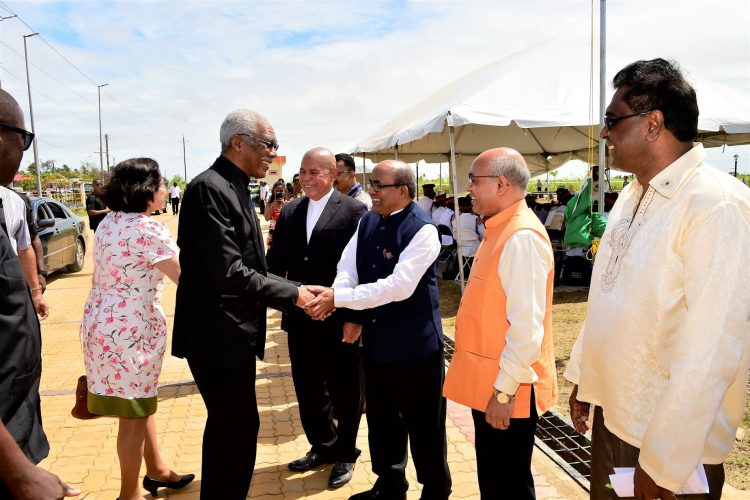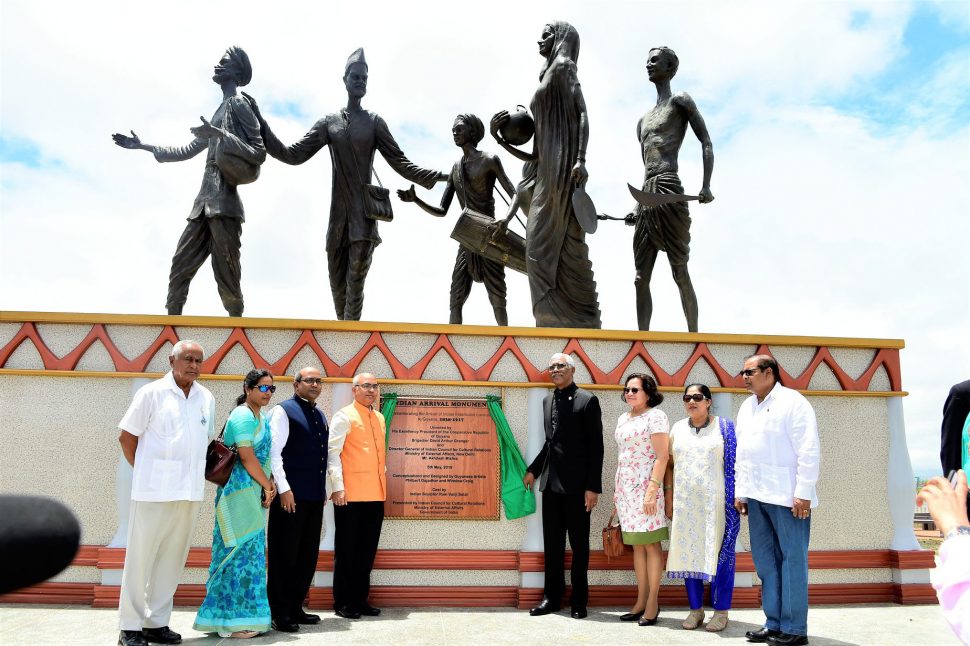Hailing the contributions of Indo-Guyanese to Guyana, President David Granger yesterday commissioned the Indian Arrival Monument at Palmyra, East Berbice, where he urged the overcoming of differences to continue to construct a cohesive country.
“The nation cannot develop to its full capacity unless it harnesses the potential of the entire population. Conditions have to be created to ensure that our peoples could live together in harmony. It is for this reason that we are pursuing the realisation of a cohesive state in which all of our people will be recognised and respected. A cohesive state is vital to ensuring a sustainable, safe and secure environment, one in which present and future generations can be happy. It is essential to protecting the legacy of past generations,” Granger told the gathering, which included Indian High Commissioner to Guyana, Venkatachalam Mahalin-gam.
Also in attendance was Akhilesh Mishra, the Director General of the Indian Council for Cultural Relations. The Government of India donated the US$150,000 bronze sculp-ture which depicts two women, three men and a child embarking on their new lives. The project, including associated site and landscaping works, was completed last year at a cost of $160 million.

In thanking the Indian government for its contribution to the project, the president yesterday said that the monument symbolises the ties of blood and history between Guyana and India. “This monument site is a shrine to Indian immigration and to the migrants’ adoption and adaptation to their new homeland,” he said.
“India’s continuing and current concern for its diaspora is reflected in its decision to support the construction of this magnificent memorial…Indian Arrival Day is commemorated today [yesterday] with the unveiling of this grand monument dedicated to the memory of Indian indentured immigrants whose exertions contri-buted to building this nation of Guyana. We are richer for their arrival and for their remaining here,” Granger added.
He traced the arrival of Indians here and their experiences. “Indians have made indelible contributions to the nation’s cultural, economic, political and social development. These contributions have ensured the community’s progress and has advanced the nation’s development,” Granger said. He also highlighted their sacrifices and said that these must not be forgotten.
“Indians are integral to our multicultural state. They, together with other ethnic groups, have gene-rated the cultural, economic and social diversity we recognise today as the Guyanese nation. They have contributed to a common culture of tolerance and mutual respect which has laid the basis, today, for the creation of a more cohesive and inclusive state,” the president said. He emphasised that Indians are integral to Guyana’s “inclusive future and always will be.” Development will be retarded unless every citizen feels a sense of belonging and enjoys equality of opportunity, the president asserted.
He told the gathering that an inclusive future involves increased integration. “It is predicated on respectful relations among all of our people. Guyana’s future must be one in which our children and grandchildren could live in a cohesive state, one in which they could enjoy a good life which our forefathers sought,” he said.
He had earlier highlight-ed Guyana’s multiculturalism and while noting the harmonious relations that exist between the different groups, said that it is the challenge of the present generation to overcome the differences that exist and to continue to construct a cohesive country. He also highlight-ed well-known Indo-Guy-anese who have made significant contributions to the country.
“Indians who have enriched every sector of society ― academics, Clem Seecharan and

Rupert Roopnaraine; attorneys, Edward Alfred Luckhoo and Stanley Hardyal; businessmen, Sattaur Gafoor and Lyla Kissoon; diplomats, Sir Shridath Ramphal and Sir Lionel Luckhoo; doctors, Balwant Singh and Deborah Persaud; trade unionists Ayube Edun and Joseph Lachmansingh; public servants, Eshwar Persaud and Lloyd Searwar; religious leaders Reepu Daman Persaud, Fazeel Ferouz and Benedict Singh, cultural champions, Rajkumarie Singh and Lakshmi Kallicharran and sportsmen Rohan Kanhai and Shivnarine Chanderpaul ― all of whom are excellent examples of Guyanese of Indian descent who attained eminence in professional and public life”, he said.
He added “We must preserve this precious multicultural heritage by working together to secure a common future where all are recognised and respected and where everyone could enjoy this country’s bounty,” Granger added.
Granger, a historian, said “Indians, as others before them, were confronted by the abuse, cruelty and domination of plantation life and they resisted, sometimes by riots and strikes.
“Our coastland is littered with memorials to the martyrs of plantation riots – at Devonshire Castle, Enmore and Rose Hall and other sites yet unmarked at Leonora, Non-Pariel, Nooten Zuil, Ruimveldt and elsewhere – where Indian labourers were killed. We must not forget their sacrifice.
“Indians protested and were punished but they persevered. They explored avenues of economic enterprise off the plantations after their indentures ended, as did the Africans, Portuguese and Chinese before them. Resistance culminated, eventually, in the decision to abolish indentured immigration in 1917.
“Indian contributions to the economy are unquestionable. Indians who began arriving even before the abolition of African enslavement in 1838 became, eventually, the main source of labour in the sugar and rice industries. They have helped to sustain these pillars of our economy for more than 180 years.
“Indian resourcefulness contributed, also, to the diversification of the rural economy through the development of cattle-rearing, cash crop and coconut cultivation, paddy-growing, rice-milling and fishing”.
Meantime, High Commissioner Mahalingam, in his remarks, said that India is pleased that the commissioning of the monument was done on Indian Arrival Day. He observed that there was heavy debate about the reason behind installing the monument at Palmyra instead of at Highbury Village, East Berbice, where the first batch of Indian indentured labourers arrived on 5th May 1838.
“I may confidently say that the selection of the site at the Palmyra Village by the esteemed Government of Guyana for installing the monument is the most appropriate and strategic location,” he said, pointing out that persons visiting Berbice through the Berbice River Bridge cannot miss the monument, since it is located directly opposite the bridge’s entrance.
Additionally, he said, while India has donated the monument itself, it is Guyana’s government which has been “quite generous in making this monument site an iconic one by constructing a beautiful park.”
Yesterday’s commissioning ceremony also saw two Indian cultural items and Mishra also gave brief remarks.






